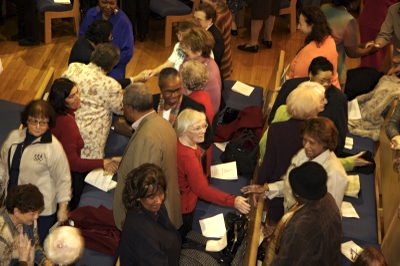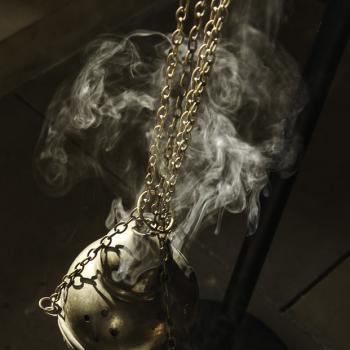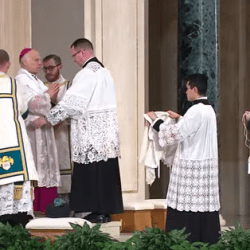I’m a recent convert with Asperger’s. I have a REAL problem with the touchy feely parts of the “ordinary” form, and I typically try very hard to go to the Tridentine for just that reason (ok, not just that one, I do love the Latin). On occasion I have no choice but to go to a different Mass. Is it the “rule” that you have to hold hands/give the sign of peace, or is it something that the pastor would call for? Needless to say, I haven’t had a whole lot of experience in this field, so I’m not really sure what to do in this case.
This raises an interesting subject. I’ve found a wide range of opinions about that moment in the Mass.
Firstly, the norms for the Mass don’t specify how it’s to be done, and it’s left to each individual conference of bishops to make recommendations, depending on local custom. Here in the U.S., that means usually a cordial handshake.
Secondly, how or even if the sign of peace is expressed is really a matter of personal choice; I give my wife a hug and a kiss, but I wouldn’t do that to a stranger sitting in the pew behind me.
But: nobody has to do it. A smile, a wave and a nod will send the same message. I’ve heard of countries where people bow to each other at that moment in the Mass. The meaning of the moment—reconciliation and an expression of genuine “peace” among neighbors—is more important than the physical gesture that expresses it. (You can even choose to refrain entirely and bow your head in private prayer if you choose, and most people will respect that.)
Last year, Jennifer Fulwiler tackled this subject in the National Catholic Register:
For those of us who are both extremely introverted and socially awkward, this sort of rampant interaction with other human beings isn’t the sort of thing you just rush into. It requires practice, preparation, and analysis on a scale not entirely dissimilar to that of a moon landing. For my fellow people who share the psychological profile of SHBDH (Should Have Been a Desert Hermit), I offer this handy guide to the strange extrovert ritual known as the sign of peace:
WHAT TO DO
- The sign of peace occurs shortly after the Our Father. You want to be able to focus on the Lord’s Prayer, so if you plan to do any warm-up exercises, stretching, or visualization techniques to prepare yourself for the hand shaking and interaction, try to do it after the Liturgy of the Word when they pass the collection plates.
- When the time comes, you engage in the sign of peace by shaking the hands of the people around you and saying, “Peace be with you.” Each handshake preferably includes a smile and at least one full second of eye contact.
- It is acceptable to say only “peace be with you” and move on to the next person. “Peace of Christ” and the abbreviated “peace” are acceptable alternatives. If so inclined, you may feel free to include spontaneous salutations such as “hi” or “good morning,” but the Church does not require that you do so.
- Some websites claim that it is acceptable to offer the Latin form of the greeting, Pax Domini sit semper vobiscum (“The peace of the Lord be with you always”), but I don’t recommend it. A non-socially-awkward person might be able to pull it off, but people like us would just end up making everyone nervous.
WHOM TO ACKNOWLEDGE
- Offer the sign of peace to all persons within a four-foot radius of where you are seated. This includes people in front of and behind you.
- If you are seated next to a group of people, it is customary to offer the sign of peace to everyone within the group, up to a maximum of 10 people. (It is acceptable, though not preferable, to pretend like you are not able to lean over far enough to shake all of their hands, and alternatively offer a small wave and lip-sync the greeting of peace. Some parishioners may choose in this case to spice things up by pantomiming an “air handshake” in lieu of a wave, though this is not required.)
- Offer to shake the hand of anyone over the age of two. You do not need to shake the hands of very young children and babies, though you are required to acknowledge them and comment on their cuteness.
Those are some starters. Read the rest.
And for those who just don’t want to touch anyone else: it’s okay. You don’t have to. Really.
Peace be with you!
UPDATE: A friend left this note on my FB page, addressing one particular detail of the original e-mail:
“It is very difficult for my Aspie daughter to make eye contact, let alone physical contact, with people who are not her family….She will lightly shake hands with one family member next to her, and then she folds her arms and looks down until the Agnus Dei.
The problem is that some folks who don’t know her peculiarities will sometimes reach for her hands and then look stunned or hurt that she isn’t ‘peacing’ them back and if they do make contact despite her trying to avoid being touched, she usually looks as if she’s been slapped. Social contact is extraordinarily difficult for her although she does try to deal with it kindly. We usually sit up front so that she has less chance of being touched since most Catholics prefer to sit at about the half-way point or further back.”












